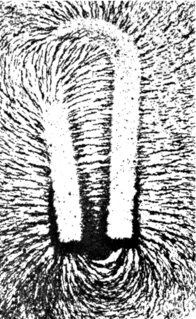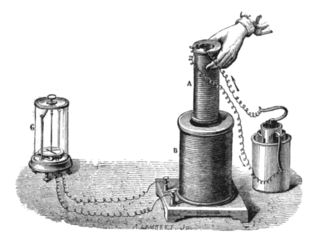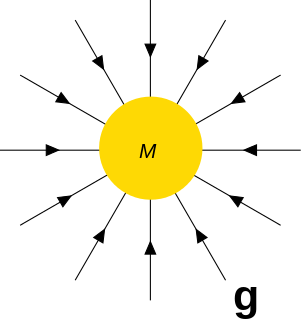
Electricity is the set of physical phenomena associated with the presence and motion of matter that has a property of electric charge. Electricity is related to magnetism, both being part of the phenomenon of electromagnetism, as described by Maxwell's equations. Various common phenomena are related to electricity, including lightning, static electricity, electric heating, electric discharges and many others.

Michael Faraday was an English scientist who contributed to the study of electromagnetism and electrochemistry. His main discoveries include the principles underlying electromagnetic induction, diamagnetism and electrolysis.

Maxwell's equations are a set of coupled partial differential equations that, together with the Lorentz force law, form the foundation of classical electromagnetism, classical optics, and electric circuits. The equations provide a mathematical model for electric, optical, and radio technologies, such as power generation, electric motors, wireless communication, lenses, radar etc. They describe how electric and magnetic fields are generated by charges, currents, and changes of the fields. The equations are named after the physicist and mathematician James Clerk Maxwell, who, in 1861 and 1862, published an early form of the equations that included the Lorentz force law. Maxwell first used the equations to propose that light is an electromagnetic phenomenon.

A magnetic field is a vector field that describes the magnetic influence on moving electric charges, electric currents, and magnetic materials. A moving charge in a magnetic field experiences a force perpendicular to its own velocity and to the magnetic field. A permanent magnet's magnetic field pulls on ferromagnetic materials such as iron, and attracts or repels other magnets. In addition, a magnetic field that varies with location will exert a force on a range of non-magnetic materials by affecting the motion of their outer atomic electrons. Magnetic fields surround magnetized materials, and are created by electric currents such as those used in electromagnets, and by electric fields varying in time. Since both strength and direction of a magnetic field may vary with location, it is described mathematically by a function assigning a vector to each point of space, called a vector field.
Timeline of electromagnetism and classical optics lists, within the history of electromagnetism, the associated theories, technology, and events.

Electromagnetic or magnetic induction is the production of an electromotive force across an electrical conductor in a changing magnetic field.

In electricity generation, a generator is a device that converts motive power into electrical power for use in an external circuit. Sources of mechanical energy include steam turbines, gas turbines, water turbines, internal combustion engines, wind turbines and even hand cranks. The first electromagnetic generator, the Faraday disk, was invented in 1831 by British scientist Michael Faraday. Generators provide nearly all of the power for electric power grids.

Faraday's law of induction is a basic law of electromagnetism predicting how a magnetic field will interact with an electric circuit to produce an electromotive force (EMF)—a phenomenon known as electromagnetic induction. It is the fundamental operating principle of transformers, inductors, and many types of electrical motors, generators and solenoids.
The Bakerian Medal is one of the premier medals of the Royal Society that recognizes exceptional and outstanding science. It comes with a medal award and a prize lecture. The medalist is required to give a lecture on any topic related to physical sciences. It is awarded annually to individuals in the field of physical sciences, including computer science.

A homopolar motor is a direct current electric motor with two magnetic poles, the conductors of which always cut unidirectional lines of magnetic flux by rotating a conductor around a fixed axis so that the conductor is at right angles to a static magnetic field. The resulting force being continuous in one direction, the homopolar motor needs no commutator but still requires slip rings. The name homopolar indicates that the electrical polarity of the conductor and the magnetic field poles do not change.

The history of electromagnetic theory begins with ancient measures to understand atmospheric electricity, in particular lightning. People then had little understanding of electricity, and were unable to explain the phenomena. Scientific understanding into the nature of electricity grew throughout the eighteenth and nineteenth centuries through the work of researchers such as Coulomb, Ampère, Faraday and Maxwell.

A dynamo is an electrical generator that creates direct current using a commutator. Dynamos were the first electrical generators capable of delivering power for industry, and the foundation upon which many other later electric-power conversion devices were based, including the electric motor, the alternating-current alternator, and the rotary converter.

Cosmos: A Spacetime Odyssey is a 2014 American science documentary television series. The show is a follow-up to the 1980 television series Cosmos: A Personal Voyage, which was presented by Carl Sagan on the Public Broadcasting Service and is considered a milestone for scientific documentaries. This series was developed to bring back the foundation of science to network television at the height of other scientific-based television series and films. The show is presented by astrophysicist Neil deGrasse Tyson, who, as a young high school student, was inspired by Sagan. Among the executive producers are Seth MacFarlane, whose financial investment was instrumental in bringing the show to broadcast television, and Ann Druyan, a co-author and co-creator of the original television series and Sagan's wife. The show is produced by Brannon Braga, and Alan Silvestri composed the backing score.

In the beginning of the 19th century, many experimental and theoretical works had been accomplished in the understanding of electromagnetics. In the 1780s, Coulomb's law of electrostatics had been established. In 1825, Ampère published his Ampère's law. Michael Faraday discovered the electromagnetic induction through his experiments and conceptually, he emphasized the lines of forces in this electromagnetic induction. In 1834, Lenz solved the problem of the direction of the induction, and Neumann wrote down the equation to calculate the induced force by change of magnetic flux. However, these experimental results and rules were not well organized and sometimes confusing to scientists. A comprehensive summary of the electrodynamic principles was in urgent need at that time.
"A Sky Full of Ghosts" is the fourth episode of the American documentary television series Cosmos: A Spacetime Odyssey. It premiered on March 30, 2014 on Fox and on March 31, 2014 on National Geographic Channel. The episode presented an in-depth treatment of black holes, beginning with John Michell's suggestion of the existence of an "invisible star" to the first discovery of a black hole, Cygnus X-1. The episode's title is an allusion to how light from stars and other cosmic objects takes eons to travel to Earth, giving rise to the possibility that we might be viewing objects that no longer exist.
"Deeper, Deeper, Deeper Still" is the sixth episode of the American documentary television series Cosmos: A Spacetime Odyssey. It premiered on April 13, 2014 on Fox and aired on April 14, 2014 on National Geographic Channel. The episode explores the smallest particles in the universe, where host Neil deGrasse Tyson "hunts for elusive neutrinos and the distant, early universe." The episode features the underground neutrino laboratory, Super-Kamiokande, located underneath Mount Kamioka in Japan.
"The Lost Worlds of Planet Earth" is the ninth episode of the American documentary television series Cosmos: A Spacetime Odyssey. It premiered on May 4, 2014 on Fox, and aired on May 5, 2014 on National Geographic Channel. The episode was directed by Brannon Braga, written by Ann Druyan and Steven Soter, and featured the voice of Amanda Seyfried as geologist Marie Tharp. The episode explores the history of the Earth starting with the period of the Late Heavy Bombardment, approximately "3.8 to 4.1 Billion years ago during which the Moon, Mercury, Venus, and the Earth were battered by space debris." Host Neil deGrasse Tyson then delves into the biography of the Earth, expressed "in its continents, oceans and life living on and in them, saying 'the past is another planet,'" alluding to how plate tectonics have shaped the Earth over millions of years.
"The Immortals" is the eleventh episode of the American documentary television series Cosmos: A Spacetime Odyssey. It premiered on May 18, 2014, on Fox, and aired on May 19, 2014, on National Geographic Channel. The episode was written by Ann Druyan and Steven Soter, and directed by Brannon Braga. The episode explores the possibility of the interstellar spread of life and possible alien encounters. The episode also presents the hypothesis of panspermia, where the origin of life is attributed to comets or asteroids carrying radiation-resistant organisms.
"Unafraid of the Dark" is the thirteenth and final episode of the American documentary television series Cosmos: A Spacetime Odyssey and its series finale. It premiered on June 8, 2014, on Fox and aired on June 9, 2014, on the National Geographic Channel. The episode was written by Ann Druyan and Steven Soter, and directed by Ann Druyan, making this her series directorial debut. The episode explores the mysteries of dark energy and dark matter, as well as the contributions and theories of Swiss astronomer Fritz Zwicky, who furthered our understanding of "supernovae, neutron stars and 'standard candles.'" The finale reveals a recording of life on Earth - the final message on the golden record of the space probe, Voyager. The episode ends with Carl Sagan's iconic speech on Earth as the "Pale Blue Dot."

Field theory had its origins in the 18th century in a mathematical formulation of Newtonian mechanics, but it was seen as deficient as it implied action at a distance. In 1852, Michael Faraday treated the magnetic field as a physical object, reasoning about lines of force. James Clerk Maxwell used Faraday's conceptualisation to help formulate his unification of electricity and magnetism in his electromagnetic theory.













